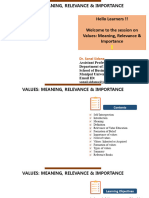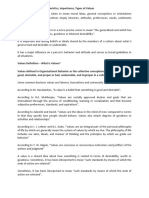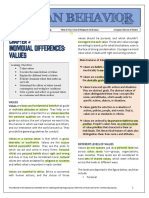0 ratings0% found this document useful (0 votes)
65 views10 pagesHuman Values Introduction
Human Values
Uploaded by
punamagr9Copyright
© © All Rights Reserved
We take content rights seriously. If you suspect this is your content, claim it here.
Available Formats
Download as PDF or read online on Scribd
0 ratings0% found this document useful (0 votes)
65 views10 pagesHuman Values Introduction
Human Values
Uploaded by
punamagr9Copyright
© © All Rights Reserved
We take content rights seriously. If you suspect this is your content, claim it here.
Available Formats
Download as PDF or read online on Scribd
You are on page 1/ 10
1
Concept and Types of Values
Concept of Values zx Type of Values zx Formation of Values ¢e
Values and Human Behaviour « Business Values
% Significance of Values in Management of Business
x Developing Value System in an Organisation
‘Value’ is a behavioural concept that influences the choice of available ends and means.
Value system or the set of beliefs held by a person determines his /her choice of
alternatives to achieve a particular end or goal. A person may prefer one course of
action to another on the assumption that his/her choice would help in realizing the
inherent values. Thus, values lay down normative standards on the basis of which
people make thier choices of alternative courses oF action. —
of each individual and are a powerful force
affecting his/her behaviour. Values are so embedded that they can be inferred ftom
people’s behaviour and their expressed attitudes. They are relatively stable and enduring.
This is because of the way they are orginally learnt from the family, educational
institutions, religious organisations and various social institutions.
Values are at the core of personal
1.1. CONCEPT OF VALUES
Miltion Rokeach had defined values_as beliefs that guide actions an
across a variety of situati
s.' He further says that values represent basic convictions
that a specific mode of conduct is personally or socially perferable to an opposite mode
of conduct. For example, a businessman is expected to supply true information about
his products rather than making false_clai —_ —
Valties determine what people consider to be good or bad for a civilised society. In
relation t&business, social valués determine the objectives of business as well as the
manner in which business affairs should be conducted. In the light of the social values,
we can evaluate policies and practices of a business. For example, an important value
of our society is honest dealings. That means the society does not approve of sale of
adulterated goods, use of false weights, hoarding of goods that or black marketing in
goods.
Values ang gy
2 . o
values “as the constellations of likes, distiy,
edward Spranger defines values “as the cos fies,
sat inner inelinations, rational and irrational judgments, prejudices and
an wy of the world.” According t0 Allpor,=q
i erson’s vie
atterns that determine a person's oe < " ; Rig
é ‘a belief upon which one acts by preference, Thus, a value can be refered y,
degree of worth or excel ject or a class of objects, To be 1"
- ;
Hence ascribed to an o! ei
ject, it is a ction of valuing trans; f
precise although credited to the object, it 18 a fun 2 ction rat
than the object itself.
‘A value represents the bas!
Ss0CI44,
ic conviction that a specific mode of conduct Cs
end state of existence is personally or socially preferable to an opposite or coy. |
verse mode of conduct or end state of existence. It contains moral flavour, Which
carries an individual's idea as to what is right, good or desirable.
Values have two attributes. The first is known as content attribute. This merely
states that the conduct or goal is important. The intensity attribute specifies just how
important it is. If we rank a person’s values in terms of their intensity, we get the
strength of that person’s value system.
Features of Values
The distinct features of values are as under:
(i) Values are comprehensive standards that direct conduct in a variety of
ways.
(ii) Values guide us to take specific positions on societal issues.
(ify Values provide standards of morality.
(iv)_Yalues are most central to the core of a person.
Values have two attributes—content and intensity. The content attribute
stresses that a particular conduct is important. The intensity attribute
specifies how important that particular conduct is.
(vi) Values transcend specific objects, situations or persons.
(vii) Values are fewer in number than attitudes.
(yi) Values are relatively stable and enduring as these are passed from one
generation to another.
Values and Ethics
Ethics refer to the entire body of moral values that society attaches to the actions of
human beings. Thus, ethics and values are interrelated. In fact, value is considered the
language of ethics. Just as there are no universally accepted standards of ethics, there
are no values which are applicable to all individuals and societies. Values can be moral,
immoral or amoral, depending upon whether they conform to, go against, or are indif-
ferent towards certain norms of morality. But ethics represent only moral values. Should
one eat vegetarian or non-vegetarian food? Should the workers’ wages be increased by
an enterprise whenever its profits increase? Such questions involve value judgement.
‘The value judgements do have ethical content when they are linked with the element of
morality, e.g., animal killing for human food is not good.
Concept and Type of Values ..
values and Attitudi
‘Avvalue system is viewed as a relatively permanent perceptual framework which influ:
ences the pattern of an individual's behaviour, Values arc similar to attitudes but are
more permanent and well built in nature, An attitude isa predisposition to respond ina
‘one’s environment. Morcover,
positive or negative way fo someone oF something in
values also involve a moral ingredient of rightness of desirability. For example, ‘Dis-
crimination in Jobs on the basis of gender is bad" indicates one’s values, On the other
hand, ‘1 favour the programme to recruit and develop women managers in the
organisation’ is an attitude,
‘Attitudes are different from beliefs and values.
viding a state of ‘readiness’ or tendency to respone
concerned with what is known about the world; they ¢
reality. Values are concerned with what ‘should’ be and what is desirable.
Gross suggests that, ‘to convert a belief into an attitude, a “value” ingredient 15
an individual's sense of what is desirable,
sted by Gross that whereas
tudes and
Attitudes can be defined as pro-
in a particular way. Beliefs are
centre on what ‘is’ consideral
needed which, by definition, is to do, with
good, valuabl
‘adults’ may
a few dozen values.
Je, worthwhile and so on’. It has been sugee
thousands of belies, they may have only hundreds of at
Values
1. Values represent, judgement of ‘what
‘ought to be. This judgement is basic
to respond in a given way.
2. A value represents single belief that
guides actions and judgements
across objects and situations.
3. Values are derived from social and
cultural mores.
4.2. TYPE OF VALUES
The classificatior
divergent: attitudes anc
values ranging from
include:
1. Reactive. Unawar
physiological needs
2, Tribalistic. High degre
and the power exercise
Jeadership.
DIFFERENCE peTwee® VALUES AND ATTITUDES
3. Attitudes are deriv
understanding as to W’
n of values facilitates an
of behavior. Graves
.d reveal different patterns
the lowest (reactive) to the
¢ of oneself and others as hut
e of dependence, strongly in
.d by authority fi
Attitudes
1. Attitudes represent predispositions
to respond.
9, Amattitude represents several beliefS
focussed on a specific object or sit-
ation.
‘ed from personal
experiences.
ny people have
has identified seven
highest (existential). These values
man beings, reaets to basic
‘uenced by tradition
gures: wants stron directive
Vales and ey,
8
individualism; aggressive aj
gged individual © and seg
desires individual responsibilities; van
in an entrepreneurial style.
eae Seas for ambiguity; difficulty in acceptin,
* ith divergent values; desires that others accept his values,
5. Srnipaatves Strives to accomplish goals by manipulating things and People,
+ evateralstic; actively seeks status and recognition.
6. Sociocentric, Desires to be liked and go along with ome rather than gey
ead dislikes materialism, manipulation and conformity; secks primary
the social relationship which a job provides. -
7. Existential. High tolerance for ambiguity and for people with divergent
values; outspoken on inflexible systems, restrictive policies, statys
symbols and arbitary use of authority; seeks full expression of growth ang
self-fulfillment of growth and self-fulfillment needs through work.
Milton Rokeach has created the Rokeach Value Survey (RVS) which
consists of two set of values, with each set containing 18 individual value items.
Exhibit 2 gives common examples of each of these sets which have been termed as (f)
terminal values; and (ii) instrumental values.”
3. Egocentrism. Believes in ru
responds primarily to powers
1 People
Terminal Vali
A terminal value is an ultimate goal or end-of a person. It might include comfortable
life, family security, sense of accomplishment, self respect, freedom (autonomy), so-
cial reopen
Instrumental Values
An instrumental value relates to the means for achieving the desired outcome or end. Ir
other words, it is a tool to acquire a terminal value.
The combination of terminal and instrumental values an individual has, create ar
enduring cluster of values called the ‘value system’.
G.W. Allport, PE. Vernon and G. Lindzey have categorised values into six major
types as follows :
1, Theoreti
tematic think:
fnterest in the discovery of truth through reasoning and sys-
The ideal theoretical man values the discovery of truth.
2. Economic. Interest in usefulness and practicality, including the accumula
tion of wealth. The ideal économic man values what is useful and is con:
ceried with practical affairs.
3. Aesthetic. Interest in beauty, form and artistic harmony. The ideal aes-
thetic man values artistic and aesthetic experiences in life, though he him-
self may not be creative,
- Social. Interest in people and human relationships. The ideal social mar
places great values on affiliation and love. He tends to be ki
thetic to other individuals. “oe me
Concept and Type of Values
Interest in gaining power and influc
reat valuc on power.
ity and understan
I religious man may be cal
tioned values. This is vet
5. Political. |
political man places g
6. Religious. Interest in uni
highest value for the ideal
It shoul
ry important
1d be noted that different people give
{ for understanding th
ncing other poople. (fhe idea!
ding the cosmos as a whole. The
Hed unity.’
different rankings to the above men-
1c behaviour of the people.
TYPES OF VALU! ES
Instrumental Values
Terminal Values
ring)
‘A.comfortable life (a prosperous life)
| Ambitious (hardworking, asp
* Broad-minded (open-minded)
i:
2. An exciting Life (a stimulating, ac-| 2
tive life)
3, A sense of accomplishment (lasting 3. Capable (competence, effective)
contribution)
4, A world at peace (free of war and | 4. Cheerful (light-hearted, joyful)
conflict)
5, Aworld of beauty (beauty ofnature | 5. Clean (neat, tidy)
and the arts)
6. Equality (brotherhood, equal oppor 6, Courageous (standing up for belief)
tunity for all)
7. Family security (taking care ofloved | 7. Forgiving (willing to pardon others)
ones)
8. Freedom (independence, free 8. Helpful (working for welfare of oth-
choice) ers)
9, Happiness (contentedness) 9. Imaginative (daring, creative)
10, Inner harmony (freedom from inner | 10. Independent (self — reliant, self —
conflict) sufficient)
11. Mature Love (sexual and spiritual ll. Intellectual (intelligent, reflective)
intimacy)
12. National security (protection from | 12. Logical (consistent, rational)
attack)
13, Pleasure (an enjoyable, leisurely life) 13, Loving (affection able, tender)
14. Salvation (saved eternal life) 14, Obedient (dutiful, respectful)
15, Self-respect (self-esteem) 15. Polite (courteous, well-mannered)
16. Social recognition (respect, admira- | 16. Responsible (dependable, reliable)
tion)
17. True friendship (close companion- | 17. Self-controlled (restrained, self-
ship) discipline)
18, Wisdom (a mature understanding of 18, Honest (sincere, truthful)
life)
Values ana gy
1.3. FORMATION OF VALUES hig,
Culture is the principal source of values. It contains as well a5 reinforces 4
Indian culture, peace, co-operation, harmony, equity, democracy and alfieg hs
values are considered desirable. Such values are not fixed but they chan, City
BE Very slows,
Recently, for example, People in India (like elsewhere) have started Westioning the
"8 the,
cherished value of possessing gold.
People indoctrinate values from their parents, teachers, fiends, media Qa.
sion, radio, newspaper) and all those whom they admire and thus, try to fol
remarkable portion ofthe values held is established in people's early yearsstom yt
ents, teachers, friends, and others. When they grow up, they are exposed to yan
value systems and accordingly, may change some of their values. Not withstand
this, basi values remain fairly constant and permanent, Even if people question suf
values they don’t change the values. As children we are told that certain values
You might also like
- Study Material-Unit One and Two - BECSR - Dr. PoonamNo ratings yetStudy Material-Unit One and Two - BECSR - Dr. Poonam24 pages
- Values State What Is Important To You As An Individual and To Your OrganizationNo ratings yetValues State What Is Important To You As An Individual and To Your Organization4 pages
- Turbinas Radiales Curso Turbomaquinas Ciclo 2020 1No ratings yetTurbinas Radiales Curso Turbomaquinas Ciclo 2020 110 pages
- #2 Values-Meaning, Relevance & ImportanceNo ratings yet#2 Values-Meaning, Relevance & Importance21 pages
- Values - Definition, Characteristics, Importance, Types of Values86% (14)Values - Definition, Characteristics, Importance, Types of Values11 pages
- The Principles and Beliefs or Accepted Standards of A Person or Social Group 2No ratings yetThe Principles and Beliefs or Accepted Standards of A Person or Social Group 29 pages
- Unit 2 Attitude Values and Motivation ValuesNo ratings yetUnit 2 Attitude Values and Motivation Values2 pages
- VALUES INTRODUCTION: Value Is An Enduring Belief That A Specific100% (1)VALUES INTRODUCTION: Value Is An Enduring Belief That A Specific15 pages
- Valuation - The Art and Science of Corporate Investment Decisions (Titman) PDF100% (14)Valuation - The Art and Science of Corporate Investment Decisions (Titman) PDF556 pages
- Business Plan Template: Professional Business Plan81% (681)Business Plan Template: Professional Business Plan26 pages
- The 100+ Business Models by FourWeekMBA - Full Library95% (41)The 100+ Business Models by FourWeekMBA - Full Library780 pages
- Strategic Human Resource Management Contemporary Issues100% (19)Strategic Human Resource Management Contemporary Issues599 pages
- Financial Management: Ariel Dizon Pineda, CPA90% (10)Financial Management: Ariel Dizon Pineda, CPA88 pages
- How To Read and Interpret Financial Statements - A Guide To Understanding What The Numbers Really Mean100% (13)How To Read and Interpret Financial Statements - A Guide To Understanding What The Numbers Really Mean179 pages
- Managerial Accounting An Introduction To Concepts Methods and Uses PDF91% (11)Managerial Accounting An Introduction To Concepts Methods and Uses PDF624 pages
- Mergers, Acquisitions, and Corporate Restructurings - Removed100% (3)Mergers, Acquisitions, and Corporate Restructurings - Removed194 pages
- A Manager's Guide To Financial Analysis 6e100% (10)A Manager's Guide To Financial Analysis 6e252 pages
- McKinsey Handbook - How To Write A Business Plan97% (29)McKinsey Handbook - How To Write A Business Plan116 pages
- Behavioural Finance Note - MBA 4th Semester100% (1)Behavioural Finance Note - MBA 4th Semester31 pages
- CFO Techniques - A Hands-On Guide To Keeping Your Business Solvent and Successful (PDFDrive) PDF100% (7)CFO Techniques - A Hands-On Guide To Keeping Your Business Solvent and Successful (PDFDrive) PDF355 pages
- Merger Acquisition and Corporate RestructuringNo ratings yetMerger Acquisition and Corporate Restructuring30 pages






















































































